An attendee only sees one thing when walking by a booth – the theme. Whether it is an all-out motif complete with themed characters and giveaways or a booth plastered in the company’s branded colors or logo, the exhibitor’s corporate message is (or should be) tied directly to its outward appearance.
In advertising, marketing experts measure an advertisement’s success by the number of impressions. What about the impression that an exhibit, which is essentially an ad, can attract on the show floor? While not every attendee may step foot inside a booth, passersby can form an impression of its look and feel in a split second.
Several exhibitors at EXHIBITORLIVE, a conference, tradeshow and corporate event for marketing professionals held March 1-5, 2015, in Las Vegas, took their booth themes to a whole new level. It is Vegas after all, isn’t it? Focusing on a specific messaging, each theme astutely enhanced the companies’ objectives while simultaneously delighting attendees and fellow exhibitors alike.
Charity
Exhibit Concepts Inc. (ECI), a design, fabrication and program management firm specializing in branded environments, tried to connect with its audience…literally. Its well-calculated campaign revolved around string art – artworks created by stretching a network of threads between accurately plotted pins.
The 20’ x 20’ space featured eye-catching abstract art created by nylon ropes and paracord woven within two wooden frames. Debbie Smyth, a textile artist from the UK, also created a live string art mural over the three-day exhibition. Revealing the images of two minds – one resembling a question mark and the other with a lightbulb – the final product perfectly reflected ECI’s motto “Where Challenges and Ideas Connect.”
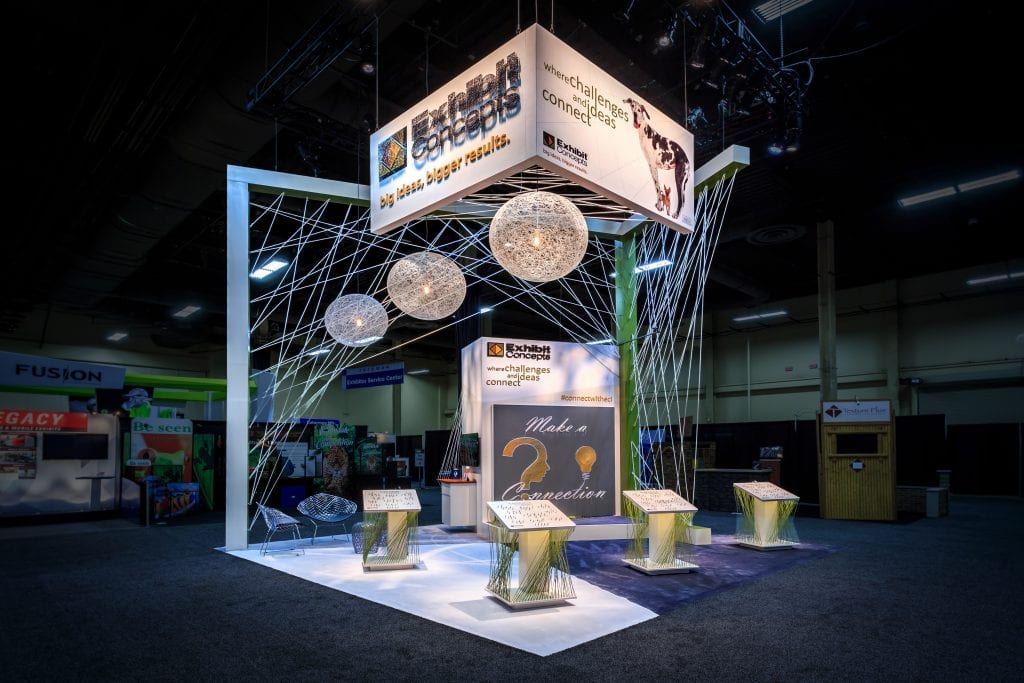
“For us, the concept is inspired by the idea of making connections with companies that value what ECI does, and that is helping them to identify their brand problems and then executing effective ideas that solve them,” explained Michael Mudry, vice president of creative & marketing, ECI. “Thus, the notion of connections led to the metaphor of String Art, where the strings are representative of the connections between us and our clients and subsequently, the solutions we connect to their challenges.”
Merging the design concept with its charity efforts, ECI selected Shoes That Fit, a national organization that provides new shoes for underprivileged schoolchildren. A donation was made on behalf of each attendee who completed the booth activity, which doubled as a qualifier.
“We’re happy that we could make our brand initiative more personal for EXHIBITORLIVE attendees by having them share in the experience of making a real connection with children in need, and we are proud to support Shoes That Fit,” shared Kelli Glasser, president and CEO, ECI.
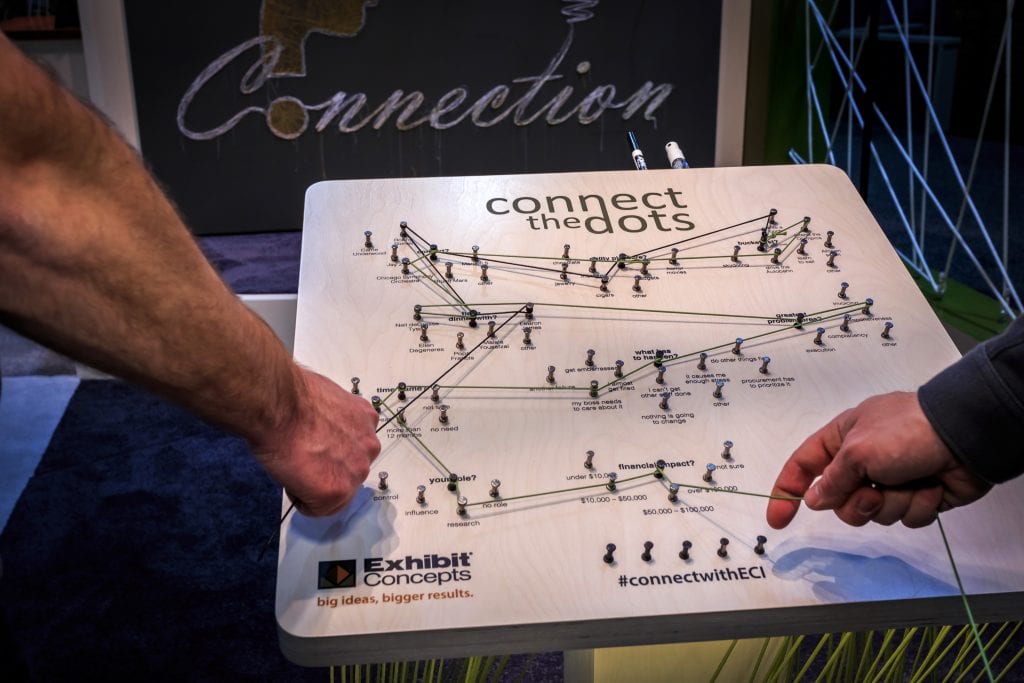
At interactive “Connect the Dots” engagement stations, attendees crafted their own individual string art. Two pieces of string were used to answer a series of questions, one by the attendee and one by an ECI representative. The activity began with amusing icebreakers, such as which musical artist one would likely go see in concert. Continuing on, industry-related questions would determine the attendee’s exhibit program needs. Respondents would answer by looping their piece of string around the corresponding pin. If both chose the same answer, then their strings would have made a connection.
“Rather than ask attendees to interact with an impersonal iPad or other digital technology that promotes Exhibit Concepts, our goal is to simply get to know the audience, identify if they have any challenges we can solve and determine if it makes sense for us to continue our conversation after EXHIBITORLIVE,” commented Mudry.
The attendee-signed “work of String Art” would be photographed and later emailed in a post-show follow-up.
“The intent is for the audience to have a non-selling and fun experience, while at the same time learning about ECI and creating a physical recording of their conversation,” Mudry added.
ECI certainly did some fancy footwork – attendees were entertained by live-marketing, engaged with an interactive questionnaire, cleverly qualified and charitably donated to a good cause simply by stepping foot inside the booth.
Giveaway
There’s nothing too special about a coffee giveaway at a tradeshow – except if you visited MG Design’s booth, a 20’ x 30’ double deck transformed into a functioning coffee shop and even staffed with national award-winning baristas.
To fully immerse attendees in the experience, MG Design, a provider of exhibit design and event planning services, offered specialty coffee orders served by waitressing booth staff. The personal service put “yo[u],” the attendee, at the center of its MuG campaign – “Great Coffee. Great Experience.”
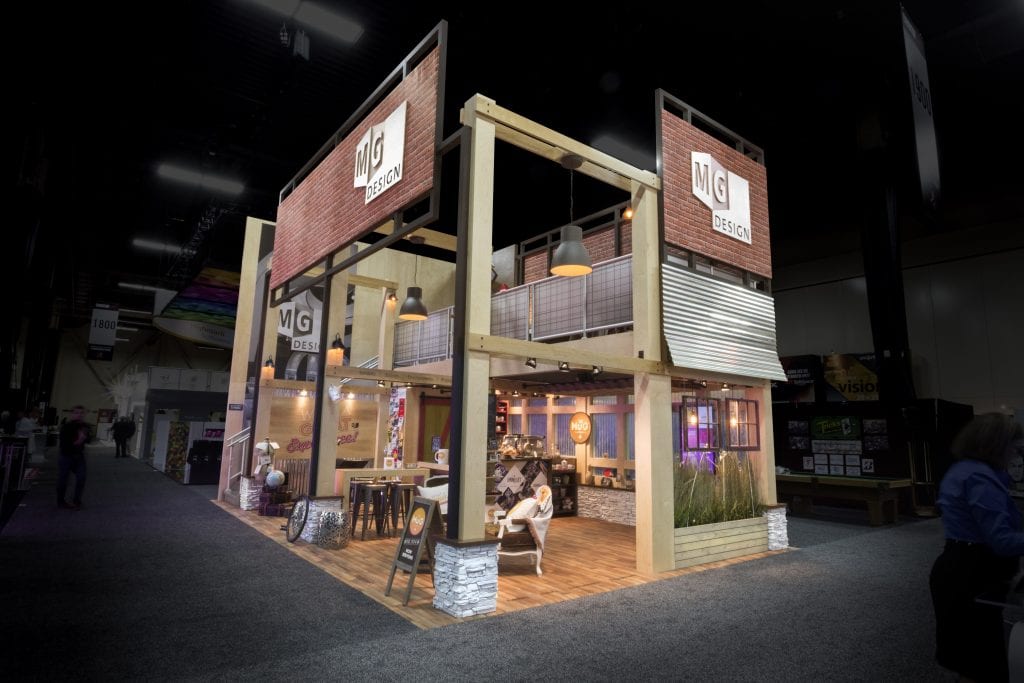
Aside from the alluring aroma, with smell being a key factor in “promoting” its coffee giveaway, MG also captured its audience through the taste of gourmet espressos and chai lattes as well as the welcoming feel of soft-cushioned seating throughout the space. Guests could hear the acoustic sounds of MG’s own Marc Schulte, an exhibit designer and accomplished guitarist, who performed an MG Design jingle composed just for the occasion. Completing the theme was a coffee table book for exhibit managers to see inspiring designs.
Creating a comfortable environment required MG Senior Exhibit Designer Ryan Scholtes to conduct field research and observe interactions at actual coffee shops.
“Technology is driving the industry, but there’s a point when it can be too much or even intimidating. People sometimes like basic interaction,” Scholtes explained.
“Most of the time you can grab someone’s attention through a good story. Using artifacts to help explain the history of your company, in some cases, is a better solution. People like history because we lived it, which makes us familiar with the subject matter, and we have a better understanding.”
Scholtes turned to MG’s own Design Attic for inspiration, the design workspace at MG’s Pleasant Prairie’s headquarters created to resemble late founder Michael Grivas Sr.’s first Chicago attic office in 1959. The team brought accessories from the current MG Design Attic and wall decorations from there to add to the authenticity of the design, which included rhinoceros head coat hangers; antique globes and suitcases representing the well-traveled, global company; and paddles from a ping pong table with which the MG team and clients are familiar.
Other elements that helped pull the look together included brick graphics to symbolize the foundation of the company and industrial fiberglass intermixed with natural wood materials to simulate an urban feel. Digital touchscreens that mimicked windows juxtaposed actual reclaimed window frames hung just adjacent to the screens, and a sliding barn door hid the storage area.
An open mic area with zany messages on a community board was the stage for Marc Schulte. Formerly a band member of Moods of Melody during design school, Schulte’s background in music came in handy when he compiled a set including approximately 15 original songs.
“Design and music go hand in hand. It’s all in the balance of simplicity versus complexity by layering sound to make something new and fresh – something that grabs and holds attention,” shared Schulte.
To create a fuller sound, Schulte, who singly played up to 40 songs over the three-day show, used a looper pedal to lay down multiple tracks on the guitar.
https://vimeo.com/122147146
Incorporating a double deck space for the first time this year, the company both showcased the addition to its rental inventory and created additional seating in a vertical space that would foster deeper conversations.
The chic space was both modern and homey, turning a simple giveaway – a cup of joe – into a fully immersive experience, one sense at a time.
Booth Activity
Group Delphi, a leading experience creation shop, has steadily built an exhibits program that seamlessly combines online and offline elements to drive engagement, and its EXHIBITORLIVE booth served as a quintessential example of this integrated approach.
Transitioning between the platforms of tradeshows, popups, events and museums, the firm is utilizing experiential design to ensure that the tangible experience is just as present as the digital, according to Justin Hersh, CEO, Group Delphi.
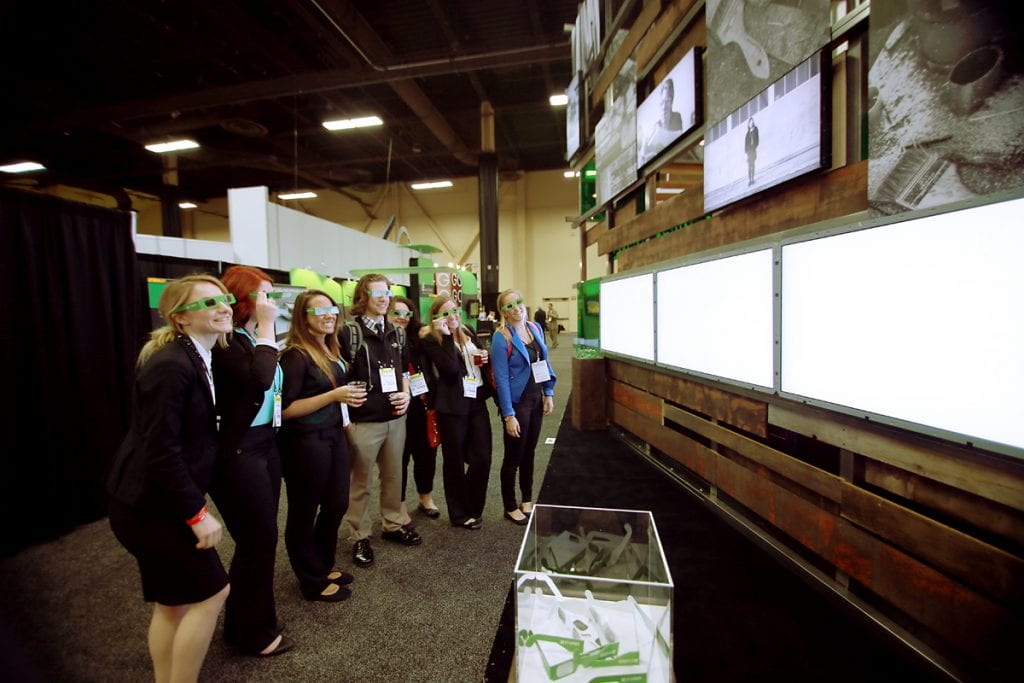
Because mass traditional media has broken up into a fragmented digital experience that lives in a mythical “cloud,” customers are seeking more from face-to-face, real experiences. Such experiences are well-positioned in the experiential space, where the digital and physical worlds converge. In line with this, the company is expanding its offerings to include interactive delivery of content in video, gaming and touchscreens that integrate with more traditional fabrication executions.
“The tradeshow model today is a fairly broken model,” Hersh explained. “Instead, sensory drives the totality of the experience, leading to more engagement and activation through an exhibit’s architecture to drive real conversation with an attendee.”
Group Delphi, therefore, believes the methods of measuring more traditional lead generation channels, like direct mail, do not work as well for the exhibit space.
“A form of measurement we are investigating is the ‘return on conversation’ to look at true engagement,” added Hersh.
Centering its EXHIBITORLIVE exhibit design on the attendee’s learning experience, Group Delphi created opportunities for personalization. Cognizant that each individual absorbs information in different ways, the company created multisensory learning activities throughout its space.
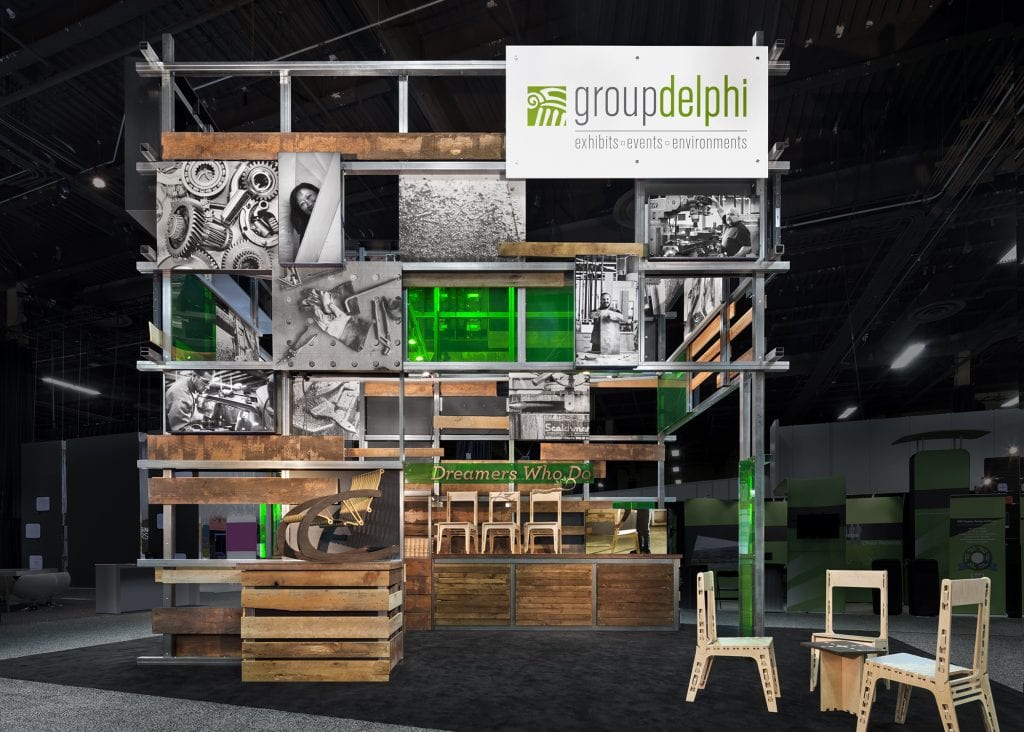
For tactile learners, a hands-on chair building exercise was both creative and functional, allowing attendees to construct and customize a furniture piece by hand. Videos of the award-winning snap-together chair and its creator educated auditory learners. Turning to its employees to populate the meaning of the Group Delphi brand, a “Wonder Wall” for visual learners required 3D glasses to view a virtual scrapbook showcasing Group Delphi employees’ jobs and personal interests.
Integrating relatable booth activities directly into the build was both resourceful and economical in design. Additionally, layering in marketing to complement the physical and digital components cleverly promoted the brand. With each activity catering to attendees’ unique learning styles, Group Delphi created an engaging, personalized experience for every single guest.





























